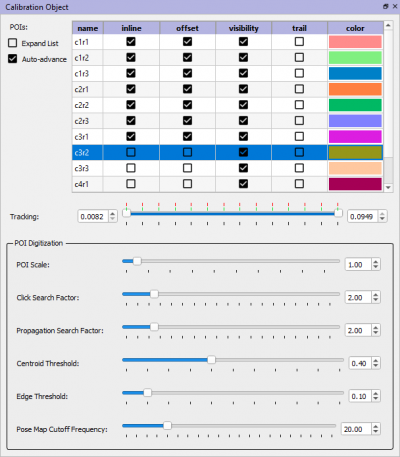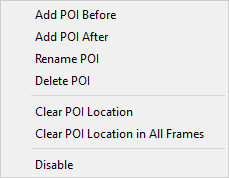CalibrateDSX: Calibration Object

The Calibration Object widget is for digitizing the points of interest (POIs) on the calibration object, so you can calculate the 3D configuration of the X-ray equipment. When you select a trial in the DSX Configuration widget, if it contains a calibration object that object will automatically be selected as well. The table in the Calibration Object widget will be filled with the object's POIs.
- Expand List
- When this box is checked, the table of POIs will expand to show all of them. When it is unchecked, the table will display ten POIs at a time.
- Auto-advance
- When this box is checked, when you have digitized the location of the current POI in both views, the current POI will automatically advance to the next one in the table which has an undefined location in at least one view.
- Tracking
- This slider controls the range of frames for the Propagate POIs command.

When you right-click on a POI in the table, a context menu is displayed with the following commands for editing the POIs:
- Add POI Before
- Adds a POI to the list before the POI that you clicked on.
- Add POI After
- Adds a POI to the list after the POI that you clicked on.
- Rename POI
- Lets you change the name of the POI that you clicked on. You can also achieve this by double-clicking on the POI name. If you change the name, you will be asked if you want to change the name of the POI in all the 2D coordinate files in all trials that use the object.
- Delete POI
- Deletes the POI that you clicked on.
- Clear POI Location
- Removes the selected POI's location from both views of the current reporting time.
- Clear POI Location in All Frames
- Removes the selected POI's location from both views for all reporting times.
- Disable
- Disables the POI that you clicked on, so that it will be skipped over when POIs are being digitized in the X-rays. Once the POI is disabled, this command in the menu changes to Enable so that you can re-enable it at a later time.
| POI Digitization |
|---|
|
This section contains the parameters that control the digitization of POIs in the X-ray images. When you are digitizing POIs in the images, there are two methods of determining the XY coordinates in the 2D images. The recommended method is to left-click on any portion of the POI in the image and let CalibrateDSX calculate the weighted center of pixels representing the POI. This process is described in detail in Digitizing POIs, and is governed by the parameters listed below. For cases in which this process does not correctly locate the POI center (e.g., non-circular POIs), you can use Ctrl-left-click to specify the point. In this case CalibrateDSX will use the exact XY coordinates of where you clicked as the 2D location of the POI in that view.
|